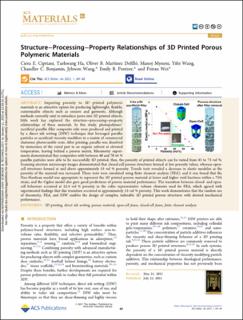| dc.contributor.author | Cipriani, Ciera | |
| dc.contributor.author | Ha, Taekwang | |
| dc.contributor.author | Martinez Defilló, Oliver | |
| dc.contributor.author | Myneni, Manoj | |
| dc.contributor.author | Wang, Yifei | |
| dc.contributor.author | Benjamin, Chandler | |
| dc.contributor.author | Wang, Jyhwen | |
| dc.contributor.author | Pentzer, Emily | |
| dc.contributor.author | Wei, Peiran | |
| dc.date.accessioned | 2023-01-12T10:02:14Z | |
| dc.date.available | 2023-01-12T10:02:14Z | |
| dc.date.created | 2021-07-28T16:23:01Z | |
| dc.date.issued | 2021 | |
| dc.identifier.citation | ACS Materials Au. 2021, 1 (1), 69-80. | en_US |
| dc.identifier.issn | 2694-2461 | |
| dc.identifier.uri | https://hdl.handle.net/11250/3042933 | |
| dc.description.abstract | Imparting porosity to 3D printed polymeric materials is an attractive option for producing lightweight, flexible, customizable objects such as sensors and garments. Although methods currently exist to introduce pores into 3D printed objects, little work has explored the structure–processing–property relationships of these materials. In this study, photopolymer/sacrificial paraffin filler composite inks were produced and printed by a direct ink writing (DIW) technique that leveraged paraffin particles as sacrificial viscosity modifiers in a matrix of commercial elastomer photocurable resin. After printing, paraffin was dissolved by immersion of the cured part in an organic solvent at elevated temperature, leaving behind a porous matrix. Rheometry experiments demonstrated that composites with between 40 and 70 wt % paraffin particles were able to be successfully 3D printed; thus, the porosity of printed objects can be varied from 43 to 73 vol %. Scanning electron microscopy images demonstrated that closed-cell porous structures formed at low porosity values, whereas open-cell structures formed at and above approximately 53 vol % porosity. Tensile tests revealed a decrease in elastic modulus as the porosity of the material was increased. These tests were simulated using finite element analysis (FEA), and it was found that the Neo-Hookean model was appropriate to represent the 3D printed porous material at lower and higher void fractions within a 75% strain, and the Ogden model also gave good predictions of porous material performance. The transition between closed- and open-cell behaviors occurred at 52.4 vol % porosity in the cubic representative volume elements used for FEA, which agreed with experimental findings that this transition occurred at approximately 53 vol % porosity. This work demonstrates that the tandem use of rheometry, FEA, and DIW enables the design of complex, tailorable 3D printed porous structures with desired mechanical performance. | en_US |
| dc.language.iso | eng | en_US |
| dc.publisher | American Chemical Society | en_US |
| dc.rights | Navngivelse-Ikkekommersiell 4.0 Internasjonal | * |
| dc.rights.uri | http://creativecommons.org/licenses/by-nc/4.0/deed.no | * |
| dc.title | Structure-Processing-Property Relationships of 3D Printed Porous Polymeric Materials | en_US |
| dc.title.alternative | Structure-Processing-Property Relationships of 3D Printed Porous Polymeric Materials | en_US |
| dc.type | Peer reviewed | en_US |
| dc.type | Journal article | en_US |
| dc.description.version | publishedVersion | en_US |
| dc.source.pagenumber | 69-80 | en_US |
| dc.source.volume | 1 | en_US |
| dc.source.journal | ACS Materials Au | en_US |
| dc.source.issue | 1 | en_US |
| dc.identifier.doi | 10.1021/acsmaterialsau.1c00017 | |
| dc.identifier.cristin | 1922899 | |
| cristin.ispublished | true | |
| cristin.fulltext | original | |
| cristin.qualitycode | 1 | |

